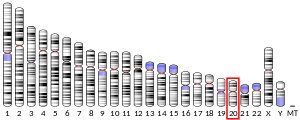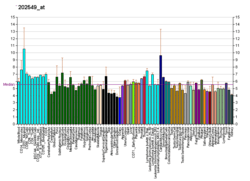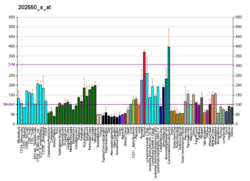VAPB
Vesicle-associated membrane protein-associated protein B/C is a protein that in humans is encoded by the VAPB gene.[5][6] The VAPB gene is found on the 20th human chromosome. Together with VAPA, it forms the VAP protein family.
Function
The protein encoded by this gene is a type IV membrane protein found in plasma and intracellular vesicle membranes. The encoded protein is found as a homodimer and as a heterodimer with VAPA. This protein also can interact with VAMP1 and VAMP2 and may be involved in vesicle trafficking.[6]
Like VAPA, VAPB binds to proteins that contain a FFAT motif.[7] Considerable interest in VAPB has arisen because mutations in this protein are associated with rare, familial forms of motor neuron disease (also called amyotrophic lateral sclerosis and Lou Gehrig's disease).[8]
References
- GRCh38: Ensembl release 89: ENSG00000124164 - Ensembl, May 2017
- GRCm38: Ensembl release 89: ENSMUSG00000054455 - Ensembl, May 2017
- "Human PubMed Reference:". National Center for Biotechnology Information, U.S. National Library of Medicine.
- "Mouse PubMed Reference:". National Center for Biotechnology Information, U.S. National Library of Medicine.
- Nishimura Y, Hayashi M, Inada H, Tanaka T (Jan 1999). "Molecular cloning and characterization of mammalian homologues of vesicle-associated membrane protein-associated (VAMP-associated) proteins". Biochemical and Biophysical Research Communications. 254 (1): 21–6. doi:10.1006/bbrc.1998.9876. PMID 9920726.
- "Entrez Gene: VAPB VAMP (vesicle-associated membrane protein)-associated protein B and C".
- Loewen CJ, Roy A, Levine TP (May 2003). "A conserved ER targeting motif in three families of lipid binding proteins and in Opi1p binds VAP". The EMBO Journal. 22 (9): 2025–35. doi:10.1093/emboj/cdg201. PMC 156073. PMID 12727870.
- Nishimura AL, Mitne-Neto M, Silva HC, Richieri-Costa A, Middleton S, Cascio D, Kok F, Oliveira JR, Gillingwater T, Webb J, Skehel P, Zatz M (Nov 2004). "A mutation in the vesicle-trafficking protein VAPB causes late-onset spinal muscular atrophy and amyotrophic lateral sclerosis". American Journal of Human Genetics. 75 (5): 822–31. doi:10.1086/425287. PMC 1182111. PMID 15372378.
Further reading
- Bastepe M, Pincus JE, Jüppner H (Dec 1999). "Two frequent tetra-nucleotide repeat polymorphisms between VAPB and STX16 on chromosome 20q13". Molecular and Cellular Probes. 13 (6): 449–51. doi:10.1006/mcpr.1999.0271. PMID 10657150.
- Paumet F, Le Mao J, Martin S, Galli T, David B, Blank U, Roa M (Jun 2000). "Soluble NSF attachment protein receptors (SNAREs) in RBL-2H3 mast cells: functional role of syntaxin 4 in exocytosis and identification of a vesicle-associated membrane protein 8-containing secretory compartment". Journal of Immunology. 164 (11): 5850–7. doi:10.4049/jimmunol.164.11.5850. PMID 10820264.
- Hu RM, Han ZG, Song HD, Peng YD, Huang QH, Ren SX, Gu YJ, Huang CH, Li YB, Jiang CL, Fu G, Zhang QH, Gu BW, Dai M, Mao YF, Gao GF, Rong R, Ye M, Zhou J, Xu SH, Gu J, Shi JX, Jin WR, Zhang CK, Wu TM, Huang GY, Chen Z, Chen MD, Chen JL (Aug 2000). "Gene expression profiling in the human hypothalamus-pituitary-adrenal axis and full-length cDNA cloning". Proceedings of the National Academy of Sciences of the United States of America. 97 (17): 9543–8. doi:10.1073/pnas.160270997. PMC 16901. PMID 10931946.
- Polgár J, Chung SH, Reed GL (Aug 2002). "Vesicle-associated membrane protein 3 (VAMP-3) and VAMP-8 are present in human platelets and are required for granule secretion". Blood. 100 (3): 1081–3. doi:10.1182/blood.V100.3.1081. PMID 12130530.
- Gevaert K, Goethals M, Martens L, Van Damme J, Staes A, Thomas GR, Vandekerckhove J (May 2003). "Exploring proteomes and analyzing protein processing by mass spectrometric identification of sorted N-terminal peptides". Nature Biotechnology. 21 (5): 566–9. doi:10.1038/nbt810. PMID 12665801.
- Clark HF, Gurney AL, Abaya E, Baker K, Baldwin D, Brush J, Chen J, Chow B, Chui C, Crowley C, Currell B, Deuel B, Dowd P, Eaton D, Foster J, Grimaldi C, Gu Q, Hass PE, Heldens S, Huang A, Kim HS, Klimowski L, Jin Y, Johnson S, Lee J, Lewis L, Liao D, Mark M, Robbie E, Sanchez C, Schoenfeld J, Seshagiri S, Simmons L, Singh J, Smith V, Stinson J, Vagts A, Vandlen R, Watanabe C, Wieand D, Woods K, Xie MH, Yansura D, Yi S, Yu G, Yuan J, Zhang M, Zhang Z, Goddard A, Wood WI, Godowski P, Gray A (Oct 2003). "The secreted protein discovery initiative (SPDI), a large-scale effort to identify novel human secreted and transmembrane proteins: a bioinformatics assessment". Genome Research. 13 (10): 2265–70. doi:10.1101/gr.1293003. PMC 403697. PMID 12975309.
- Nishimura AL, Mitne-Neto M, Silva HC, Oliveira JR, Vainzof M, Zatz M (Apr 2004). "A novel locus for late onset amyotrophic lateral sclerosis/motor neurone disease variant at 20q13". Journal of Medical Genetics. 41 (4): 315–20. doi:10.1136/jmg.2003.013029. PMC 1735732. PMID 15060112.
- Nishimura AL, Mitne-Neto M, Silva HC, Richieri-Costa A, Middleton S, Cascio D, Kok F, Oliveira JR, Gillingwater T, Webb J, Skehel P, Zatz M (Nov 2004). "A mutation in the vesicle-trafficking protein VAPB causes late-onset spinal muscular atrophy and amyotrophic lateral sclerosis". American Journal of Human Genetics. 75 (5): 822–31. doi:10.1086/425287. PMC 1182111. PMID 15372378.
- Amarilio R, Ramachandran S, Sabanay H, Lev S (Feb 2005). "Differential regulation of endoplasmic reticulum structure through VAP-Nir protein interaction". The Journal of Biological Chemistry. 280 (7): 5934–44. doi:10.1074/jbc.M409566200. PMID 15545272.
- Rual JF, Venkatesan K, Hao T, Hirozane-Kishikawa T, Dricot A, Li N, Berriz GF, Gibbons FD, Dreze M, Ayivi-Guedehoussou N, Klitgord N, Simon C, Boxem M, Milstein S, Rosenberg J, Goldberg DS, Zhang LV, Wong SL, Franklin G, Li S, Albala JS, Lim J, Fraughton C, Llamosas E, Cevik S, Bex C, Lamesch P, Sikorski RS, Vandenhaute J, Zoghbi HY, Smolyar A, Bosak S, Sequerra R, Doucette-Stamm L, Cusick ME, Hill DE, Roth FP, Vidal M (Oct 2005). "Towards a proteome-scale map of the human protein-protein interaction network". Nature. 437 (7062): 1173–8. doi:10.1038/nature04209. PMID 16189514.
- Hamamoto I, Nishimura Y, Okamoto T, Aizaki H, Liu M, Mori Y, Abe T, Suzuki T, Lai MM, Miyamura T, Moriishi K, Matsuura Y (Nov 2005). "Human VAP-B is involved in hepatitis C virus replication through interaction with NS5A and NS5B". Journal of Virology. 79 (21): 13473–82. doi:10.1128/JVI.79.21.13473-13482.2005. PMC 1262604. PMID 16227268.
- Nousiainen M, Silljé HH, Sauer G, Nigg EA, Körner R (Apr 2006). "Phosphoproteome analysis of the human mitotic spindle". Proceedings of the National Academy of Sciences of the United States of America. 103 (14): 5391–6. doi:10.1073/pnas.0507066103. PMC 1459365. PMID 16565220.
- Perry RJ, Ridgway ND (Jun 2006). "Oxysterol-binding protein and vesicle-associated membrane protein-associated protein are required for sterol-dependent activation of the ceramide transport protein". Molecular Biology of the Cell. 17 (6): 2604–16. doi:10.1091/mbc.E06-01-0060. PMC 1474796. PMID 16571669.
- Conforti FL, Sprovieri T, Mazzei R, Ungaro C, Tessitore A, Tedeschi G, Patitucci A, Magariello A, Gabriele A, Labella V, Simone IL, Majorana G, Monsurrò MR, Valentino P, Muglia M, Quattrone A (2006). "Sporadic ALS is not associated with VAPB gene mutations in Southern Italy". Journal of Negative Results in Biomedicine. 5: 7. doi:10.1186/1477-5751-5-7. PMC 1481594. PMID 16729899.
- Kanekura K, Nishimoto I, Aiso S, Matsuoka M (Oct 2006). "Characterization of amyotrophic lateral sclerosis-linked P56S mutation of vesicle-associated membrane protein-associated protein B (VAPB/ALS8)". The Journal of Biological Chemistry. 281 (40): 30223–33. doi:10.1074/jbc.M605049200. PMID 16891305.





